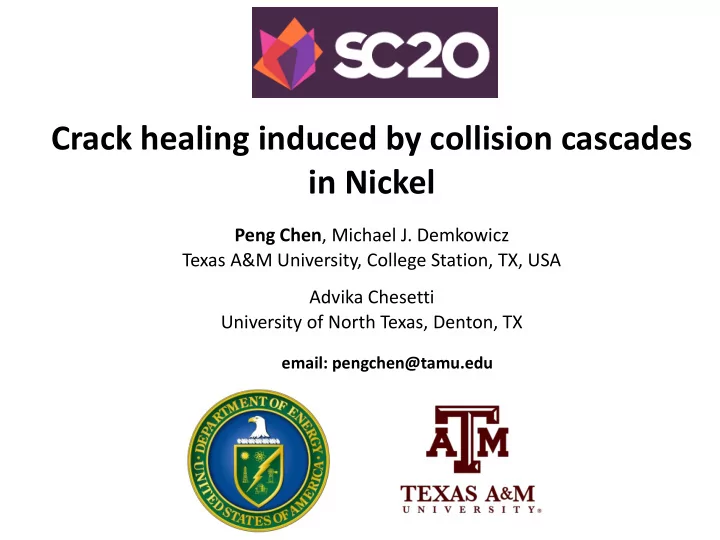

Crack healing induced by collision cascades in Nickel Peng Chen , Michael J. Demkowicz Texas A&M University, College Station, TX, USA Advika Chesetti University of North Texas, Denton, TX email: pengchen@tamu.edu
Motivation ❖ Nanoscale cracks could be inadvertently ❖ Metallic structural components in nuclear introduced into materials during processing reactors are exposed to radiation damage. or in service. Atomistic simulation of radiation-induced defect creation Gao et al. / Computational Materials Science, 2017 Nordlund et al. / Nature Communications, 2018 For the structural metallic material in nuclear power engineering, such as nickel, the interaction between nanoscale crack and collision cascade is inevitable. Questions: 1. How collision cascades and the generated damage affect structure of nanoscale cracks? 2. How crack influences the collision cascade and the formation of radiation damage? Peng Chen/ Crack healing induced by collision cascades in Nickel 2
Simulation methodology • HPRC cluster: Ada • LAMMPS for MD simulation • Ovito for visualization Configuration of simulation cell — Ni single crystal with a nanoscale crack Simulation setup: A nanoscale crack ( 𝜚 = 50 Å) is introduced at the center of simulation cell, crack surface ∥ 111 plane. 1) 2) The collision cascade is initiated by imparting a kinetic energy to a primary knock-on atom (PKA). Four scenarios: different distances of PKA above the crack — 10, 40, 70 and 100 Å; for each scenario three different PKA directions — 0°, 45° and 90° are further considered. As such, the interaction between collision cascade and crack can be investigated, the effect of PKA positions and velocity directions can also be studied. Peng Chen/ Crack healing induced by collision cascades in Nickel 3
Results: collision cascade induced-crack healing ➢ PKA distance=10 Å; kinetic energy=10 keV Collision cascade: 1. 0.01 ps: ballistic phase 2. 0.05 ps: collision cascade spreads out 3. 0.30 ps: thermal spike core expands to its maximum size 4. 26.10 ps: collision cascade has already cooled down to equilibration Crack structure after radiation ⇒ Representative snapshots of the microstructural evolution at different times ❑ the thermal spike core grows to maximum size and overlaps with crack, and the crack can be partially healed ❑ dislocation loops and stacking faults are generated after equilibration Peng Chen/ Crack healing induced by collision cascades in Nickel 4
➢ PKA distance=70 Å; kinetic energy=10 keV Representative snapshots of the microstructural evolution at different times ❑ Irrespective of PKA directions, no overlapping between crack and thermal spike core occurs, and no crack healing is observed ❑ After equilibration, the radiation damage is mainly in the form of point defects, almost no dislocation loop and stacking fault can be observed Peng Chen/ Crack healing induced by collision cascades in Nickel 5
Trends in cascade-induced crack healing Reduction of crack surface area varies markedly with both PKA direction and distance : ❑ as the PKA distance is increased, the number of crack surface atoms also increases, indicating the crack is more difficult to be closed. ❑ the 90° direction is more effective in healing the crack than the 0° and 45° directions, due to the larger fraction of overlapping crack area with thermal spike core. ❑ Once the PKA distance is greater than 70 Å, no crack healing can occur, due to the thermal spike does not overlap with the crack.. Peng Chen/ Crack healing induced by collision cascades in Nickel 6
Trends in cascade-induced crack healing ❑ the number of Frenkel pairs is significantly increased when the PKA distance is increased from 40 Å to 70 Å. ❑ When crack overlaps with thermal spike core (at 10 Å and 40 Å), a considerable amount of dislocations are activated. However, the dislocation length is nearly zero when no overlapping occurs Peng Chen/ Crack healing induced by collision cascades in Nickel 7
Discussion and Summary ✓ Collision cascade induced-crack healing: the crack can be healed when crack overlaps with a thermal spike core and remains intact when no overlapping occurs. ✓ The overlapping of crack with thermal spike core affects the radiation induced-defects: dislocation loops and stacking fault tetrahedra dominate when the crack overlaps with thermal spike. However, the point defects dominate when no overlapping occurs. Peng Chen/ Crack healing induced by collision cascades in Nickel 8
Recommend
More recommend